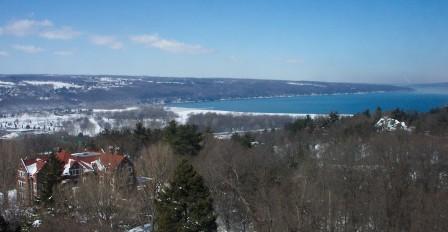Rochester’s local media is busy interpreting — make that, trying to interpret — documents relating to past engineering evaluations of the South Avenue Parking Garage. One of the garage’s ramps collapsed on April 21. It was shortly after 5 on a Friday. It’s a miracle nobody was hurt or worse.
Well, here’s something to think about: I don’t see how anyone makes heads or tails out of this until we sort out what’s meant by “helix” and “cantilevered slab.” Oh, and “helix joints.”
The ramp itself was a corkscrew shape. A helix.
But as I puzzled over the media reports from the last 48 hours, it struck me that at least some of the engineering documents may be calling the garage itself a “helix.”
So I did a little googling, and apparently when you’re talking about parking garages, “helix” can refer to the design within the garage proper. When you’re twisting back & forth to find a parking place — or to get back to the street, on your way out — you’re negotiating a helix.
Here’s an exterior photo of a “six-level double helix” parking garage. Here’s a photo of another parking garage, the text description of which notes
Internally, the garage features a “double helix” ramp design that prevents cars from going in opposite directions on the same ramp.
So keep that in mind as we tour what the local media is saying, now, about the collapse. ABC affiliate Channel 13, for example, has a piece up that states
A January 1, 2005 letter to the city from the project’s engineering consultants, Stantec Consulting Group raised concerns about the part of the helix that connects to the garage. The firm had been working with the city since the late 1990s on a plan to rehabilitate the garage . . .
The consultants’ letter said, “we identified deteriorating conditions at the cantilevered slab extending from the garage to the double helix structure to the south. We feel that conditions have progressed to a state where vertical shoring for the edge of the cantilevered slab is required.”
Okay. So there was a problem between a cantilevered slab and a double helix. But does the “double helix structure to the south” refer to the ramp? It seems to, given the context.
Second question: what’s the “cantilevered slab”? A cantilever is a beam that has one end projecting into space. So look at this photo of the garage in happier days. To my amateur eye, the only thing I can see that I’d describe as “cantilevered” on that building is the ramp.
Now here is NBC affiliate Channel 10’s version:
On Wednesday city hall made hundreds of pages of documents available to the media. Those papers shed light on serious structural problems at the garage . . .
The spiral exit ramp on Broad Street is what engineers call a helix [yeah, sure, but I think we have to be careful, since “helix” has another common usage in discussing the design of parking garages — Ed.] but none of the documents provided to the media showed any serious concern for the helix. [But which “helix”?]
. . . The documents are filled with complex, detailed engineering language. The earliest ones date to 1998 when the garage was 27 years old. The report showed there was a serious problem with deterioration of the cantilevered slab that extends from the garage itself to the helix exit ramp.
Okay. This makes it sound like the “cantilevered slab” is a structure that connects the garage and the ramp . . .
One document recommended shoring up the cantilever slab. A notation written in the margin said urgent. The slab had sagged over time and was creating depressions at the expansion joints. The report said the slab was flexing more under wheel traffic at the joint and there was a series of hairline to one-eighth inch wide cracks. Exploratory holes drilled revealed corroded reinforcing steel and poor quality concrete at the joint and the underside of the helix ramp exhibited cracks.
So somebody did notice that the “cantilever slab” was sagging. And then this happened. (Note, however, that according to Channel 13, the city claims to have implemented the recommendations made by Stantec in January 2005.)
Now let’s look at how the Democrat and Chronicle is reporting this. It also references the “hundreds of pages of documents” that the city released this week and then says
The reports did highlight some structural issues, including deteriorating joints between the garage and the adjacent, yet structurally separate, ramp.
But most of those issues were largely addressed, according to city officials and Daniel Hogan, president of Crane-Hogan Structural Systems Inc., which is now renovating the 32-year-old garage.
City officials say the greater concern was the structural integrity of the garage itself, and that’s why city officials had approved a major $6 million renovation project. Engineers are currently studying the soundness of the garage as well as trying to determine what caused the ramp collapse.
The next paragraph in the article refers to a “cantilevered section” (?):
Officials say that warnings from a 2004 report from the Rochester engineering company Stantec Consulting Group Inc. focused largely on a cantilevered section of the garage, and those problem areas would not have caused the collapse. Those warnings of structural deterioration were highlighted Thursday in a Democrat and Chronicle story that incorrectly related the deterioration to the ramp itself, rather than the cantilevered section. Steps had been taken to shore up the weak areas in the cantilevered area, officials and contractors said.
Well if the “cantilevered section” is a concrete structure that connects the ramp to the garage, then saying its problems were “related to the deterioration of the ramp” seems pretty accurate to me. The ramp can’t just suspend itself in midair.
Back to the Channel 13 article.
Documents also show the city knew in 1998 the helix [again, which helix?] would need repairs. The same engineering firm [i.e. Stantec], then known as Sear-Brown, recommended repairing the helix joints by 2003, at a cost of $1.06 million. That work had not happened by the time of last month’s collapse . . .
It’s not known if the structural weaknesses pointed out by the consultants in 2005 led to the collapse. It’s also not known if the joint replacement work recommended to be completed by 2003 would have prevented the collapse.
Confused?
Me, too.
The D&C also quotes city Corporation Counsel Thomas Richards as saying:
“Somehow, somewhere the severity of the problem with the helix ramp was missed.”
No kidding.
You have to wonder if the city officials responsible for interpreting the engineers’ reports were able to do so.
Please leave a comment if you spot any inaccuracies in how I’ve sorted this all out, so far.
UPDATE: I edited my comments after my first quote from the Channel 13 story. At first my (late-night!) working theory was that the “double helix” referred to in Stantec’s January ’05 letter couldn’t be the ramp. Now I’ve reread it again and changed my mind.



